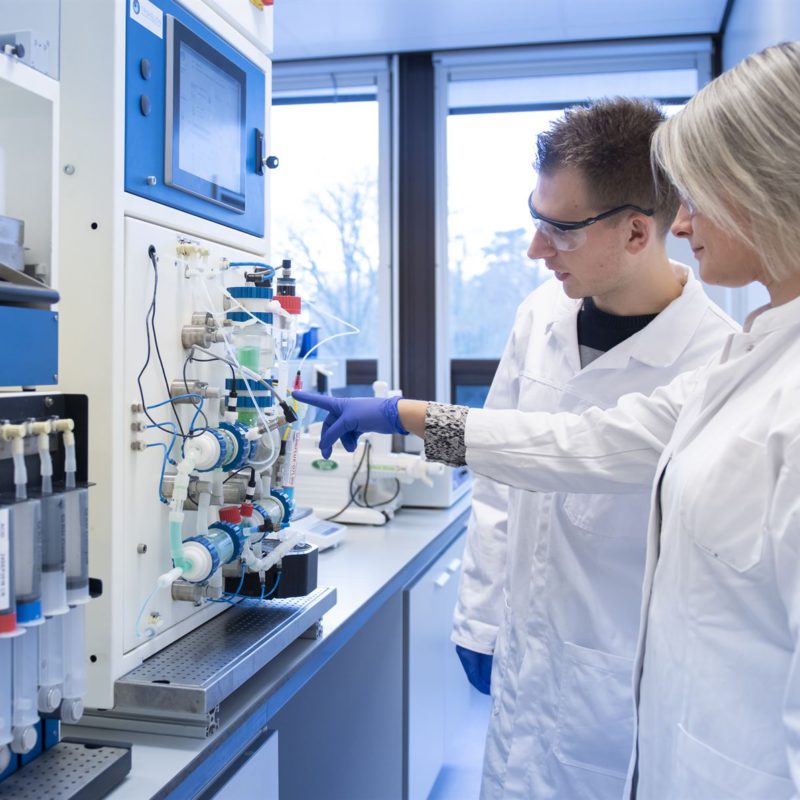TIM Academy
FAQ
Applications questions

Can disintegration of modified release formulations be studied under physiologically simulated GI conditions in TIM? What is a House Keeper Wave?
The formulation is introduced in the gastric compartment. Here, the formulation is exposed to the gastric conditions: gastric content, which is a mixture of secretion juices, hydrodynamic (shear) forces and pressure forces (both due to peristalsis). Depending on the type of coating the formulation will disintegrate in the stomach or will be transferred intact to the small intestine. In case a formulation in the stomach does not disintegrate into particles < 2-7 mm, the formulation will (partly) stay in the stomach ‘waiting’ for the House Keeper Wave (HKW). These are physiological strong gastric contractions of an nearly empty stomach to remove large particles from the stomach into the small intestine. We simulate this movement in the TIM system by removing the formulation from the stomach compartment and introduce it into the small intestine compartment. For reasons of standardization, we simulate the HKW for the fasting state at 60 min after intake of the formulation with water and for the fed state at 180 min after intake of the formulation with the meal. In case of a second meal, we can ‘postpone’ the HKW, e.g. till ≥ 360 min.
Can you calculate for the stability or enzyme activity of a compound in the jejunum and ileum?
Based on the analysis of the concentration of compounds (e.g. proteins) in the lumen samples from the TIM compartments we can calculate the rate of ‘stability’ or ‘activity’ in relation to the initial intake based on a computer-simulation program for the GI transit and volumes.
How do you combine the two separate systems (TIM-1 and TIM-2), e.g. for sustained release formulations or ‘pre-digestion’ studies?
We collect ileum effluent and ileum residue, including the remaining fraction(s) of the formulation, at the end of the TIM-1 experiment. This material is used for ‘feeding’ the TIM-2 system. This is done immediately after collection or after storage of the effluent / residue fractions at 0-4 ºC or at minus 20 ºC. Depending of type of study and/or type of formulation/food, we simulate the colon transit for up to 24 hours. During this time, we collect lumen and dialysate samples at different timepoints from TIM-2. The results of this combined TIM-1 and TIM-2 study provides the kinetic profile of the compounds released, solubilized and availability for absorption in time (e.g. from 0 to 24 or 30 h).
Do you have colon microbiota simulation models for disease conditions?
We have experience with inoculation of the TIM-2 system with (individual or pooled) stools of (healthy / diseased) humans, pigs and dogs (less with rat, ducks, chicken). The TIM-2 system has also been used to study the activity of the microbiota of IBD and Ulcerative Colitis patients (van Nuenen et al.). Fresh fecal samples were used and compared to the activity of that of healthy volunteers. It is possible to obtain and innoculate stable ‘diseased’ microbiota in TIM for short term experiments (up to 3-4 days). We have shown that the activity of the microbiota in fresh fecal samples is higher than that in healthy volunteers. This might be one of the reasons for a perpetuated inflammation. We investigated this further focusing on the effect of the microbiota on immuno modulation through production of microbial metabolites. We have found very interesting results of certain metabolites down-regulating the immune response (in in vitro-ex vivo experiments), which may be very relevant for IBD patients (van Nuenen et al.).
When you perform studies with diseased persons (e.g. IBD) how reliably can you transfer a "colitis microbiota" to a stable microbiota in TIM-2?
We are aware of the localization differences between TIM-2 and the colon in terms of mucosal adhering bacteria versus bacteria present in the lumen. However, with respect to microbial activity, especially the population in the lumen is of importance. Dietary substrate availability for adhered microbiota is limited, and these adhered populations may primarily feed on mucus and exfoliated epithelial cells. Also they may cross-feed on metabolites produced by the bulk of the luminal microbiota. We find it difficult to envisage how a drug can have exclusive effects on the adhered microbiota, unless it acts from the direction of the mucosa instead of from the lumen (e.g. drug is taken up in the small intestine and through the blood circulation reaches the colonic mucosa and from there interacts with the adhered microbiota; however, we have difficulties imagining this). In our view most drugs are present luminal (whether or not after enterohepatic circulation) and will affect the microbial population there. This may in turn have its effect on the adhered population, as they are a reflection of the luminal population one way or another. Experiments of Zoetendal et al. have shown that the microbiota in biopsies and that in the lumen correlate at least to a certain extent.
Do you have colon microbiota simulation models for animal species?
We have experience with inoculation of the TIM-2 system with (individual or pooled) stools of pigs and dogs. We can use fresh coecal samples (slaughter house pigs) or fresh stools (e.g. dogs) whether or not standardized in the fed-batch fermentor as mentioned above.
Do you have experience on studying the behavior of drug products in TIM-1 model (dynamic dissolution tests)?
The TIM systems are validated and applied for a broad variety of APIs (BCS class 1 to 4) in an broad variety of formulations. Over 150 different APIs in more than 270 formulations have been tested: e.g. tablets, capsules, suspensions, micro- and nano- particles, IR, CR, SR formulations. Besides, the TIM system has been validated successfully for a broad scope of food & nutrition applications, which is important for studying drug-food and drug-nutrient interactions. These TIM (validation) results are documented in over 160 peer-reviewed publications and more than 600 The TIM Company reports.
Can you give some examples of compounds that were successfully studied in the TIM-lipid configuration?
The majority of the drug- and nutritional compounds we test in TIM are BSC class 2 with highly lipophylic character (log P > 3). For example: propranolol, atenolol, glipizide, lipid soluble vitamins (e.g. vitamin A), lycopene isomers, beta-carotene, lutein and various fats (digestibility). Other more lipophylic compounds (e.g. generics and NCEs) have been studied successfully.
Do you have experience on antibiotic induced alterations of microbiota in TIM-2 system?
We perform comparative studies with known and new antibacterials in TIM-2 and use either conventional culturing methods or DNA-based methods (sequencing) to compare (dose-related) changes in microbiota composition, whether or not in combination with analysis on microbial metabolites. We also have experience in testing the effect of antibiotic residues in food products of animal origin (milk, meat). We studied the effect of these residues after single and repeated intake on the composition and metabolic activity of colon microbiota as well as the period it takes to restore the misbalance of the colon microbiota (data used in safety dossiers for government).
Do we have experience in TIM with large molecules or biologicals (e.g. peptides, proteins)?
We have experience with large molecules in relation to study their release, transit, stability, functionality, bioconversion etc. For example: casein phosphopeptides (different MW; polypeptides with 25 to 50 amino acids), immunoglubulins (e.g. IgG; stability during GI transit under various GI conditions; food matrices); food-allergens (e.g. peanut proteins, ovalbumin, ovo-mucin, casein, gluten (10-90 kDa; gradual breakdown during GI transit); exo-enzymes: xylanase, phytase, lipases, proteinases (stability, activity, efficacy); active lipid compounds: sphingolipids (stability during GI transit; activity on intestinal transport).


